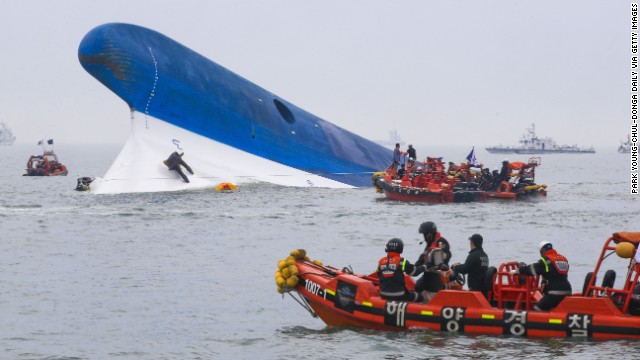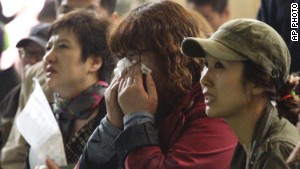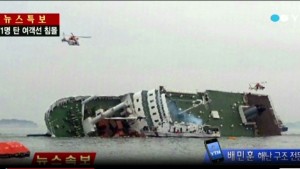South Korean shipwreck survivors: Passengers told 'don't move' as ship sank
April 16, 2014 -- Updated 2112 GMT (0512 HKT)
Source: CNN
STORY HIGHLIGHTS
- Survivor: "Kids were forced to stay put, so only some of those who moved survived"
- Death toll rises to six, according to CNN affiliate YTN
- Nearly 300 remain missing, but exact numbers are unclear
- Many passengers jumped from the ship into the freezing water below
Jindo, South Korea (CNN) -- Passengers aboard a sinking South Korean ferry faced a terrifying choice as the vessel rolled: obey commands barked over loudspeakers to stay in place, or don life vests and jump into the chilly ocean water.
"Don't move," a voice warned, according to a recording obtained by CNN affiliate YTN. "If you move, it's dangerous. Don't move."
That announcement, some witnesses worried, may have cost some passengers on the ferry Sewol their lives.
"Kids were forced to stay put," one survivor told CNN affiliate YTN, "so only some of those who moved survived."

Source: CNN


As rescuers searched the frigid water for nearly 300 people who remained unaccounted for, witnesses told horrific stories of their final minutes on the sinking ship.
"We were told to stay where you are, so we kept staying," survivor Hyun Hung Chang told YTN. "But later on, the water level came up. So we were beside ourselves. Kids were screaming out of terror, shouting for help."
At least some of those who jumped or made their way to the top of the ship were rescued. Helicopter crews plucked some from the deck.
Others were pulled from the water by crews aboard the multitude of fishing boats and military vessels that raced to the scene as the ship rolled over and capsized.
"I had to swim a bit to get to the boat to be rescued," Lim Hyung Min, one of more than 300 Seoul high school students who was aboard the ship for a four-day field trip, told CNN affiliate YTN. "The water was so cold and I wanted to live."
CNN affiliate YTN cited South Korean emergency response officials in reporting that six people were dead. The semiofficial Yonhap News Agency was still reporting four deaths early Thursday, mirroring what officials had told CNN on Wednesday.
At least 164 had been rescued, although some media reports put the number at as many as 179.
A massive rescue operation resumed early Thursday after a delay of several hours, the South Korean Coast Guard told CNN. The reason for the delay was unclear.
Dozens of military divers, sailors, marines and police officers were assisting in the effort.
But cold water, swift currents and low visibility appeared to be complicating the rescue operation.
Water temperatures in the area are between 50 and 55 degrees Fahrenheit (about 10 to 13 degrees Celsius), CNN meteorologist Brandon Miller said.
Divers from the South Korean navy searched three of the ship's compartments but found no survivors or bodies, Yonhap reported.
The U.S. Navy ship USS Bonhomme Richard, on routine patrol in the area, diverted to the scene and was standing by in case South Korean officials ask for help, said Lt. Arlo Abrahamson, spokesman for the U.S. Navy in South Korea.
"The Republic of Korea has done a great job in their rescue efforts thus far," he said.
Rescuers are "up against every sort of obstacle," said David Gallo, director of special projects at the Woods Hole Oceanographic Institution.
"It's just an absolutely, positively horrific situation," he said. "It's nightmarish."

Approximate location
A tilt and a bang
It began as a routine ocean trip on calm seas. Passengers bound for a resort island were just stirring, some eating breakfast.
The ship ran into trouble just before 9 a.m. as it steamed toward to Jeju, a resort island considered the Hawaii of Korea.
Passenger Kim Sung-Mook told YTN that he was eating breakfast in the ship's main hall when he felt the ferry begin to tilt.
Someone made the announcement telling passengers to stay in place. Then, he said, he heard a loud bang.
Lim, the rescued student, told YTN he heard the bang before the ship began to list. The tremors knocked shipping containers off balance, he said.
"The students were falling over and crashing into things and bleeding," Lim said.
Many passengers screamed.
He obeyed orders to stay on the ship until rescuers arrived, threw him a life jacket and told him to jump.
The water, he said, was "unbearably cold."
At first, survivor Ji Chul Song said she listened to orders to stay put.
"But suddenly, the water came up to my face," she told YTN. "So I think it was a narrow escape from dying."
Massive damage?
What caused the ship to sink is unknown. It capsized within two hours of its first distress call, which came just before 9 a.m., Yonhap reported
Peter Boynton, a retired U.S. Coast Guard captain, said the speed with which the ship sank suggested it had sustained "major damage."
It most likely struck something in the water, Boynton said.
Making matters worse, the ferry carried dozens of vehicles. Once an auto deck is breached, "it's typically open to very significant flooding," Boynton said. That could explain "why the ferry in just a matter of hours began to roll onto its side so quickly."
Catherine E. Shoichet and Michael Pearson wrote and reported from Atlanta; Paula Hancocks reported from Jindo, South Korea; translator Hyoun Joo Song and CNN's Holly Yan, Jessica King, Karen Smith, Josh Levs, Euan McKirdy, Stella Kim, Frances Cha, Madison Park and Judy Kwon also contributed to this report.
April 16, 2014 -- Updated 1142 GMT (1942 HKT)
It was supposed to be a class trip to a resort island. Instead, the ferry capsized, turning the afternoon into a deadly nightmare.
April 16, 2014 -- Updated 1731 GMT (0131 HKT)
It's hard not to be nervous, standing outside the Ebola isolation wards.
April 16, 2014 -- Updated 1258 GMT (2058 HKT)
Ukraine says it's forces have regained control of an airfield from Russian separatists. Nick Paton Walsh reports.
April 16, 2014 -- Updated 1135 GMT (1935 HKT)
An "extraordinary" video shows what looks like the largest and most dangerous gathering of al Qaeda in years.
April 14, 2014 -- Updated 1230 GMT (2030 HKT)
Explore each side's case, reconstructed from Pistorius' court affidavit and the prosecution's case during last year's bail hearing.
April 14, 2014 -- Updated 2116 GMT (0516 HKT)
Officials are launching their next option: an underwater vehicle to scan the ocean floor.
April 16, 2014 -- Updated 1753 GMT (0153 HKT)
How are police preparing for this year's 26.2-mile marathon, which takes place Monday?
April 15, 2014 -- Updated 1702 GMT (0102 HKT)
Romance is hard, for anyone. For people with intersex traits, love poses unique challenges.
April 16, 2014 -- Updated 1238 GMT (2038 HKT)
It's no easy matter becoming a world class tennis player. It's even harder when everyone (really -- everyone) is calling you the "new Martina Hingis".
April 16, 2014 -- Updated 2126 GMT (0526 HKT)
The "kill switch," a system for remotely disabling smartphones and wiping their data, will become standard in 2015.
April 16, 2014 -- Updated 1632 GMT (0032 HKT)
Browse through images you don't always see on news reports from CNN teams around the world.
April 15, 2014 -- Updated 1851 GMT (0251 HKT)
Sky gazers caught a glimpse of the "blood moon" crossing the Earth's shadow Tuesday in all its splendor.
April 15, 2014 -- Updated 1509 GMT (2309 HKT)
This solar-powered aircraft will attempt to circle the globe next year.
Most Popular
Today's five most popular stories
52°
HI 60°LO 46°
London, United KingdomWeather forecast
Home | Video | World | U.S. | Africa | Asia | Europe | Latin America | Middle East | Business | World Sport | Entertainment | Tech | Travel | iReport
Tools & Widgets | RSS | Podcasts | Blogs | CNN Mobile | My Profile | E-mail Alerts | CNN Shop | Site map | CNN Partner Hotels

































No comments:
Post a Comment